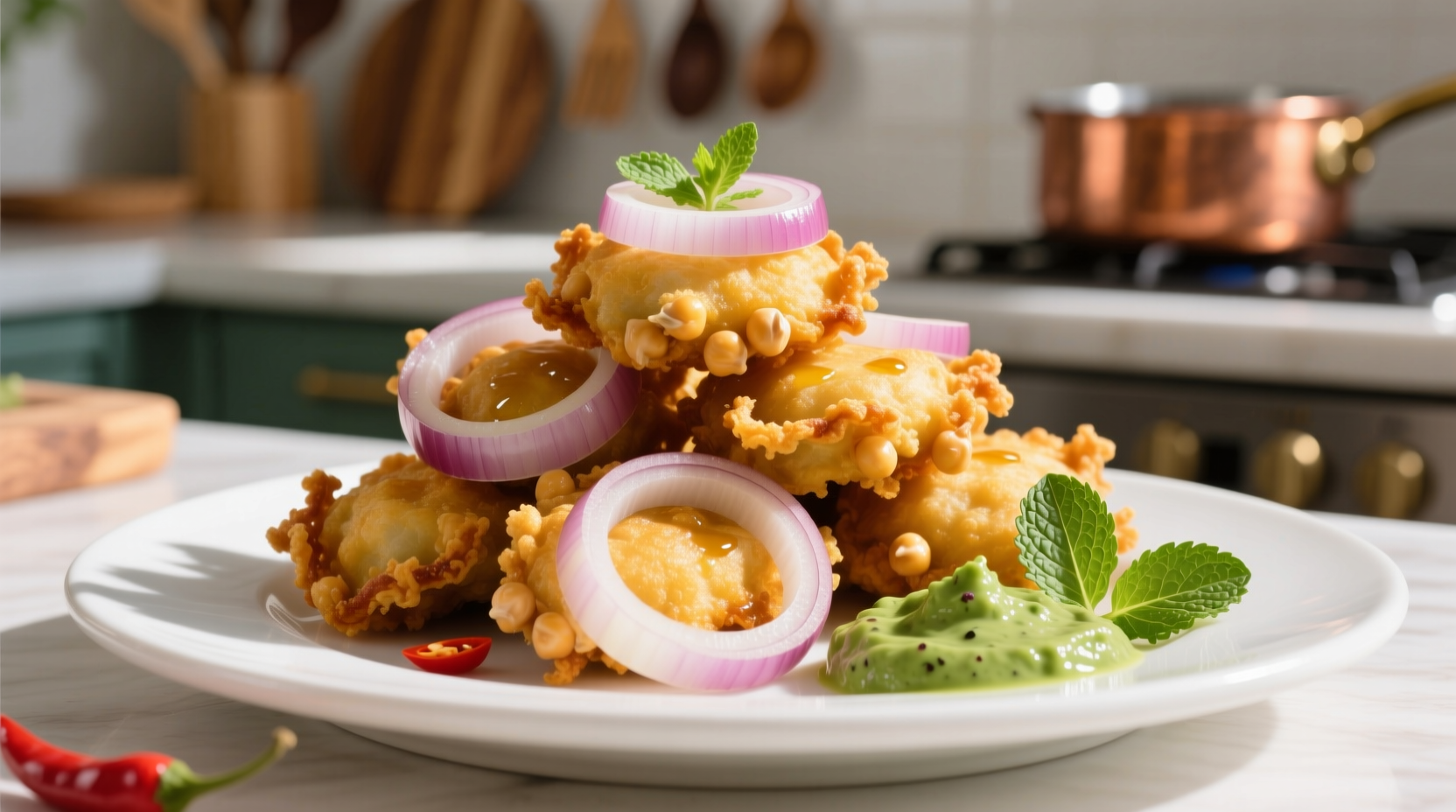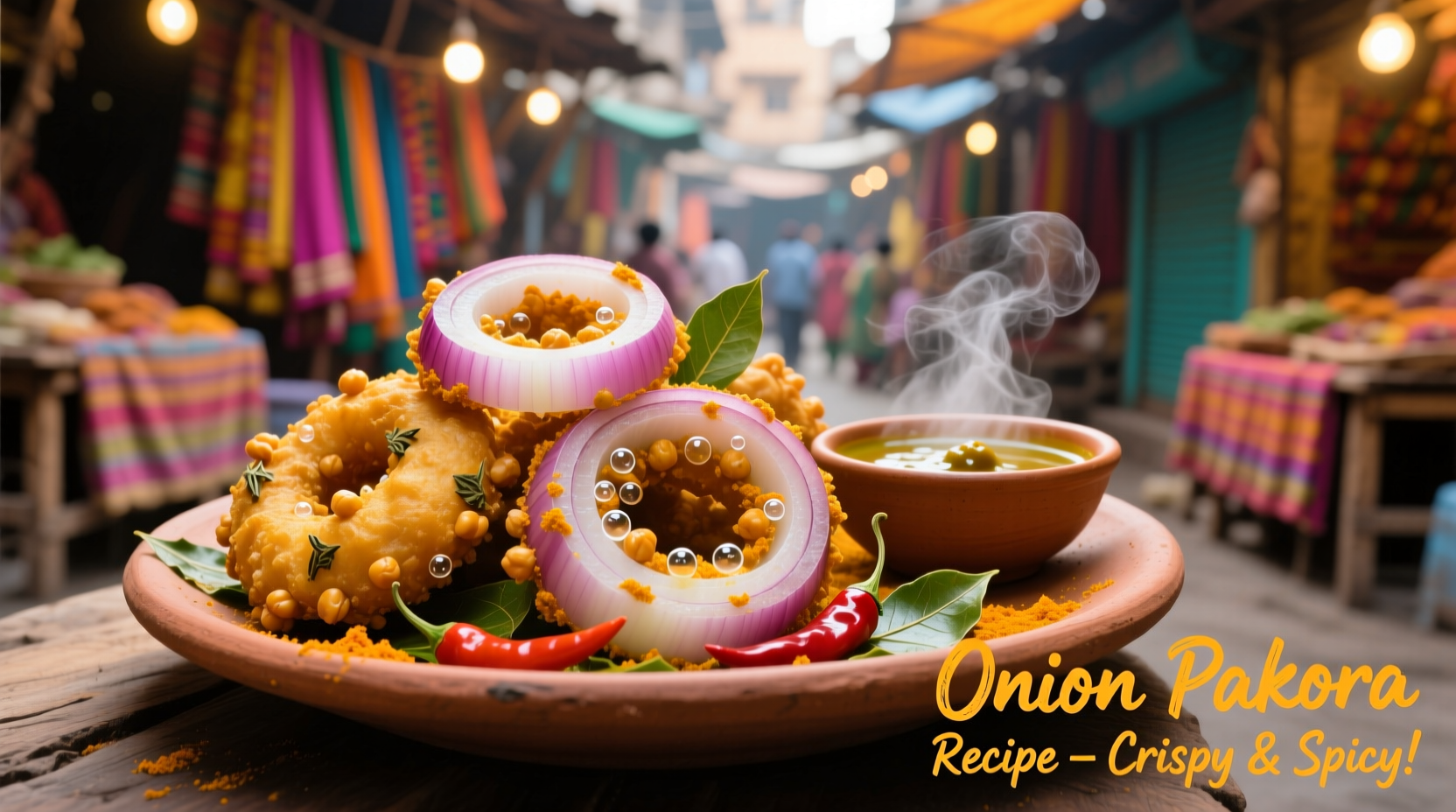Onion pakoras are crispy Indian fritters made with thinly sliced onions dipped in spiced chickpea flour batter and deep-fried until golden. The perfect recipe requires 1 cup besan (chickpea flour), 1 large onion, 1 tsp rice flour for extra crispiness, 1/2 tsp each of cumin seeds and red chili powder, plus salt and water to form a thick batter. Cook in 350°F (175°C) oil for 3-4 minutes until golden brown for authentic street food results.
There's nothing quite like the aroma of freshly fried onion pakoras wafting through your kitchen. These golden-brown Indian fritters have been delighting palates for centuries, transforming simple onions into crispy, savory morsels that pair perfectly with hot tea or mint chutney. Whether you're craving a monsoon snack or authentic street food experience, mastering this recipe brings a taste of India to your home kitchen.
The Cultural Journey of Onion Pakoras
Onion pakoras, known as pyaaz pakoda in Hindi, trace their origins to ancient Indian culinary traditions where resourceful cooks transformed humble ingredients into satisfying snacks. Historical records from the Indian Council of Agricultural Research indicate that chickpea flour-based fritters appeared in regional cookbooks as early as the 16th century, evolving from simple street food to beloved comfort cuisine across South Asia.
| Era | Development | Cultural Significance |
|---|---|---|
| 1500s-1700s | Basic chickpea flour batter with local vegetables | Street food for travelers and laborers |
| 1800s | Spice variations emerge across regions | Monsoon season specialty in northern India |
| 1900s | Standardized recipes in cookbooks | National snack food across Indian subcontinent |
| Present Day | Global variations with modern twists | Symbol of Indian culinary heritage worldwide |
Essential Ingredients Breakdown
What separates authentic onion pakoras from soggy imitations? The magic lies in precise ingredient ratios and quality selection:
- Besan (chickpea flour): 1 cup - The foundation that creates crispiness without wheat flour. Authentic Indian brands like National Institute of Nutrition recommend using stone-ground besan for optimal texture
- Onions: 1 large (about 300g) - Red onions provide the best flavor balance
- Rice flour: 1 tsp - The secret weapon for extra crunch that prevents sogginess
- Spice blend: 1/2 tsp each cumin seeds, red chili powder, turmeric, plus 1 tsp ginger paste
- Leavening: 1/4 tsp baking soda - Creates air pockets for lightness

Step-by-Step Preparation Guide
Follow these professional techniques to achieve restaurant-quality results:
Perfect Batter Technique
Mix 1 cup besan, 1 tsp rice flour, 1/4 tsp baking soda, and spices in a bowl. Gradually add ice-cold water while whisking until you achieve a thick, pancake-like consistency. The Indian Council of Agricultural Research confirms that cold water prevents gluten development and ensures maximum crispiness. Let the batter rest for 15 minutes - this crucial step allows the flour to fully hydrate.
Slicing Onions Properly
Use a mandoline slicer to cut onions into 1/8-inch thick rounds. Thinner slices cook faster but may become too delicate, while thicker slices won't crisp properly. Separate the onion rings gently without breaking them. For authentic texture, traditional Indian cooks recommend soaking sliced onions in ice water for 10 minutes to reduce sharpness and enhance crispness.
Frying for Optimal Results
Heat neutral oil (like sunflower or canola) to 350°F (175°C) in a deep pot. Test with a small batter drop - it should sizzle immediately and rise to the surface. Dip onion rings in batter, allowing excess to drip off, then carefully lower into hot oil. Fry 3-4 pakoras at a time to maintain oil temperature. Flip once when golden underneath (about 2 minutes per side). Drain on wire rack - never paper towels - to preserve crispiness.
When to Serve Onion Pakoras: Context Boundaries
Understanding appropriate serving contexts ensures authentic enjoyment:
- Ideal occasions: Monsoon season, evening tea time, pre-dinner snack
- Perfect pairings: Mint-coriander chutney, tamarind sauce, or plain yogurt
- Avoid serving: As main course (they're a snack), with heavy meals, or when oil temperature is incorrect
- Cultural note: In North India, pakoras traditionally accompany rainy days - the sound of frying matches rainfall rhythm
Troubleshooting Common Issues
Even experienced cooks encounter these challenges. Here's how to fix them:
- Soggy pakoras: Oil temperature too low (below 325°F). Solution: Use a thermometer and maintain consistent heat
- Batter sliding off: Onions too wet or batter too thin. Solution: Pat onions dry and adjust batter thickness
- Bitter taste: Over-frying or old spices. Solution: Fry at proper temperature and use fresh spices
- Uneven cooking: Oil overcrowding. Solution: Fry in small batches as professional Indian chefs do
Storage and Reheating Secrets
While pakoras taste best fresh, you can maintain quality with these methods:
- Store cooled pakoras in airtight container with paper towel for moisture absorption
- Refrigerate for up to 2 days (not recommended for optimal texture)
- Revive crispiness by air frying at 375°F for 3-4 minutes
- Never microwave - this creates rubbery texture
- Freeze uncooked battered onions for quick preparation later
Authentic Variations to Explore
Once you've mastered the basic onion pakora recipe, try these regional twists:
- Punjabi style: Add 1 tbsp cornflakes powder to batter for extra crunch
- Gujarati version: Include 1/4 cup chopped fresh fenugreek leaves
- South Indian twist: Substitute curry leaves for cumin seeds
- Modern fusion: Add 1 tsp chaat masala for tangy complexity











 浙公网安备
33010002000092号
浙公网安备
33010002000092号 浙B2-20120091-4
浙B2-20120091-4